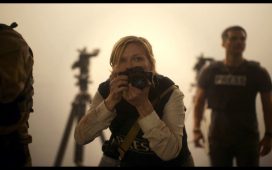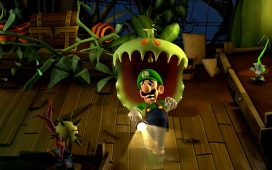“Without film-making my life is meaningless,” says Salvador Mallo, the depressed director at the heart of Pedro Almodóvar’s new film. He’s ageing, he’s ailing and lives all by himself in a big flat full of memories. His friends have all left and he fears his best work is behind him. Time is ticking; his body is breaking down. When Mallo is wheeled into theatre for a routine operation, it could almost be a dress-rehearsal for his death.
Almodóvar points out that the film is a fiction. He has no interest in documentaries and would never dream of making one. So the character of Mallo is not him, not really, even if Antonio Banderas dressed in the director’s clothes to play the role, even if the film’s interiors were shot inside the director’s own flat, even if Mallo’s life largely corresponds with his own. But his defence is crumbling; he throws up his hands. “I’m trying to convince myself I’m talking about a character,” he says. “But deep down I know I’m talking about myself. So go ahead, ask me anything. I can no longer hide behind Salvador Mallo.”
We meet inside his production office in Madrid, on a nondescript side street just west of the bullring. Almodóvar sits ramrod-straight at his desk, a snowy-haired man with a puckish smile and mournful eyes and a notepad in his hands that he doodles on as he speaks. The wall behind is studded with framed pictures: a peroxide Penélope Cruz; a signed portrait of Billy Wilder. Many of the pictures show the director in his younger days, when his hair was jet black and his stare more pugnacious. The ghosts of the past are literally lined at his back.
Actually, I don’t think Almodóvar has ever hidden behind his movies. Or if he has, the disguise has never amounted to more than a playful fig-leaf, a bit of powder and paint. In his rude, boisterous youth he made rude, boisterous pictures. In well-upholstered middle-age he made plush melodramas and thrillers. But he’s now knocking 70 and suffering through an undignified low comedy of back problems, tinnitus and spiritual malaise. Pain and Glory, then, is an old man’s confessional. It may also turn out to be his late-life masterpiece.
The director nods curtly. “I’m extremely proud of the film,” he says and then hastens to clarify. All his films have flaws; some just have fewer imperfections than others. “So perhaps I should say I’m extremely proud of certain scenes in this film.”
Joining us in the office is Claire, the translator. Almodóvar’s back is in uproar but Claire’s left leg is even worse. She felt something give when the bus hit the brakes; she thinks she’s pulled a muscle. The leg doesn’t hurt when she’s sitting down, but God only knows how she’s going to get up from her chair. Almodóvar decides we’ll cross that bridge later. He’ll carry her out if need be, assuming his dodgy back doesn’t snap. The three of us sip at our drinks and exchange nervous glances. This could turn out to be a major issue.
Almodóvar’s films are full of similar moments: anguished human dramas edged with knockabout farce. In Pain and Glory, Mallo squabbles with his friends, mangles a live interview and self-medicates with opiates. The tone is mercurial, offsetting pathos with humour. Almodóvar’s palette has darkened and his thoughts have turned inward. As a film-maker, though, his step is arguably lighter than it has ever been in the past. Pain and Glory leads us on a merry dance.
Inside the office, Almodóvar talks in a rush, slaloming from Spanish to English and back again. Without film-making, Mallo’s life has no meaning. And yes, of course, that’s what the director thinks too. It’s probably how he’s always felt. But these days the drumbeat is only getting louder. “I rely on it, it’s an addiction, the need to tell stories. If anything, my relationship with film has become more tense, more of a problem, because there is always that question: when will my time be up? Will this be the last film I make?” He draws a horizontal line on the pad; puts a notch near the end. “Perhaps this is the reason I haven’t developed any other facets of my life. Quite the opposite, I think I’ve cut back. So I’ve now reached the point where film is the only thing that makes me feel whole. Cinema is the only thing I have. It’s finished up being both the end and the means for me.”

His lifestyle might make him feel whole as an artist. Does it make him incomplete as a person? He winces. “Good question. It definitely dominates my life. But it’s what you get used to. Personally, I’ve got used to not needing other people. I’ve let them go. I’ve cut them off. I suppose I could get them back if I wanted. But I’d need a spur. I’d need a reason.”
Is this where most great artists wind up: in an ivory tower, contemplating the stars? It somehow runs counter to the abiding spirit of Almodóvar’s work, which has always been about noise, colour, incident; the rub and thrust of bodies in close quarters. His best films are like something you might pick up from Madrid’s El Rastro flea-market: well-thumbed and outrageous, a gorgeous gift to the world.
Almodóvar was born in smalltown La Mancha. His dad ran a petrol station, his mum a bodega. Making Pain and Glory involved digging back into his past. So he cast 10-year-old Asier Flores as his childhood self: soulful, out of place and stirred to a state of swooning lust by the sight of a handsome labourer in the buff.
Near the end of the film, Mallo turns to his dying mother and says: “I’ve failed you simply by being as I am.” Again, this is a sentiment he can relate to himself.
“Oh yes,” he says and clears his throat. “In fact I was never the son my parents wanted. I mean, I think that they really loved me. But it’s something I realised from a very young age.”
He doesn’t blame them so much as the time and the place. Mum and dad were manchegos: the region made them what they were. “I was born in 1949 and La Mancha was highly conservative, extremely backward. My parents were effectively living in the 19th century and they gave birth to a son who was almost like a 21st-century child.
“So there was a massive gap between their expectations and mine. They wanted me to stay in the village, get married, get a job in a bank. In fact, they did find me a job in a bank and I turned it down.” He glares at me; he glares at Claire. “I just hated village life. I was horrified by it, even when I was little. So much inbreeding. Everyone looking inwards and at each other. The only thing that mattered was what your neighbours were doing and what they thought of you. So for me it was hell. All I wanted to do was get out, run away.”
In 1970s Madrid he was adopted by a wild new family. La Movida Madrileña was a loose coalition of artists (musicians, artists, theatre groups) that flourished after the death of General Franco. Almodóvar explains that La Movida took its lead from pretty much everything – British punk and glam, American new wave, the 60s sexual revolution, Andy Warhol’s Factory scene – but that it was also a purely Spanish phenomenon, a great upsurge of creativity, a reaction to decades of oppression. His time with La Movida was a dream come true, the best experience of his life. And it was only possible because he had fled La Mancha and because ding-dong, the witch was dead. Or as he puts it: “Franco had to die so that I could live.”

What made La Movida so special was that it was instant, spontaneous, a banquet of street food to be consumed on the run. “It was a revolution in Madrid, almost. We had journalists coming every day to try to understand what was going on. Then I read the articles and it was clear they didn’t understand it. It was too specific, too chaotic, and they were too chaotic themselves, too much a part of the story. They took too many drugs and it showed in their writing.”
I picture Almodóvar at the time as a curious, Clark Kent figure. By night he wrote comic-strip stories, performed fringe theatre and sang in a band. He bought a Super-8 camera and shot silent sex comedies and profane Bible tales which he would then project on the walls at nightclubs and bars, often standing beside the screen to provide a bellowed running commentary. But by day he held down a job at Telefónica, the state telephone company. For 12 years he worked as an office administrator, keeping tabs on faulty phones that had been returned, and only quit in the 80s after his film career took off. When 1988’s Women on the Verge of a Nervous Breakdown picked up an Oscar nomination, his mother said that thiswas probably a good time to call Telefónica and ask for his old job back.
Actually, he says, the salary was a safeguard, the job kept him grounded. “La Movida was open, it was permissive and the night just went on and on. And yes, I had first-hand experience of all that, the endless nights, but it was different for me because I had to get up the next day. And maybe that’s what saved me. I was surrounded by all the excesses, all the drugs. But I knew I had to write my scripts at home and that I had to go to work every morning. Every party I went to, I was always the first one to go home.”
An assistant pokes her head around the door to check how we’re doing. A dark-haired toddler is parked on her hip. Almodóvar lights up at the sight of the child. He pulls frowning faces, plays peek-a-boo with his hands. Claire takes this opportunity to check her leg. If anything, it’s worse; it won’t take any weight. “I think I must have torn some ligaments,” she says.
Like La Movida, Almodóvar’s films pinched from a wide range of sources: the high-flown Hollywood melodramas of Douglas Sirk and George Cukor; the glossy perversities of Alfred Hitchcock; the grubby transgressions of Warhol and John Waters. Like La Movida, they came with a personal stamp and a distinct Spanish flavour. And as the director matured, his work changed too, shifting from the spiky exuberance of pictures like Labyrinth of Passion and Tie Me Up! Tie Me Down! towards the lush, liquid exoticism of All About My Mother and Broken Embraces. Along the way he became arguably the country’s most bankable cultural export, a global brand, very nearly a monopoly.
Almodóvar insists he was as surprised as anyone. He always assumed he’d be a cult director at best. He says international stardom has been wonderful in that it’s allowed him to retain complete control of his career. The downside is that it estranged him from most members of his old cohort. “Envy arrives on the scene, and that’s very unpleasant. You find it’s suddenly hard to talk to your friends. And the reason for that is the success that you’ve had.”

Fame, perhaps, is the worst thing that can happen to a grassroots scene like La Movida. Every flash of the spotlight bleaches out its dark corners. Every giant leap forward risks betraying core principles. One minute Almodóvar and Banderas, his regular player, were making polysexual comedies they figured would play to a dog and two transvestites. The next the director was being feted by high-profile fans like Madonna, while Banderas had remade himself as a bona fide Hollywood star, propping up studio fodder like Spy Kids, The Expendables 3 and the Zorro pictures.
Banderas once told me that Almodóvar had felt annoyed and betrayed when the actor moved to the US. The director blinks when I mention this. “Did he? I didn’t know that I dared to tell him that to his face. But yes, I guess I was. I mean, I was happy for his success. But he had been the protagonist of almost all my movies in the 80s. And I felt like a mother who has lost her son. It was like he’d left home. And obviously for me home meant being in Madrid, working for me.”
When Pain and Glory screened at Cannes in May it prompted speculation that here at last was a film to win Almodóvar a Palme d’Or to set alongside his Goyas, Oscars and Baftas. Instead it was Banderas who walked away with the best actor prize. The director approves. He says that this is Banderas’s best performance since 1989’s Tie Me Up! Tie Me Down! – then realises that this might be construed as a double-edged compliment, given that Tie Me Up was the last film they made before the actor jumped ship. He doesn’t want to cause offence; he’s glad he has his actor back (they reconciled to collaborate on the 2011 thriller The Skin I Live In). “Actually,” he concedes, “it’s probably his best performance ever.”
Every now and again, he considers tackling Hollywood himself. He came within a whisker of making both Brokeback Mountain and The Paperboy. Back in the early 90s – rather more alarmingly – Touchstone Pictures wanted him to direct Sister Act, the Whoopi Goldberg vehicle about singing nuns. But on balance he has decided he’s better off in Madrid. He lives alone, surrounded by his books and his paintings and 3,000 DVDs, in a large apartment near the Malasaña district. Once, long ago, Malasaña was the base of La Movida. It was a barrio of crumbling brick warehouses and dingy clubs. Since then the cash has poured in and the place has been gentrified. The director has changed. The city has too.
Before she died in 1999, Almodóvar’s mother sat down to map out her own funeral. She decided how the service would be and what dress she would wear. She’d heard that the morticians had a habit of binding the corpse’s feet so that they didn’t splay out in the casket and stipulated that, if this should happen, her children should immediately untie her. She didn’t want her feet bound; she planned to run free. evisiting this exchange when writing the script for Pain and Glory, Almodóvar abruptly found himself breaking down in tears.
His mother, he says, wasn’t scared of dying; he always admired that about her. “But it’s one of my worries, I can’t get over it in my mind. I mean, I can’t even reconcile myself to the fact that death is real. Plus I’m an atheist, so I have no belief in the afterlife and no creed to help me out. I see the whole thing as unnatural, I know that sounds odd.” He snorts. “So yes, I’m definitely afraid of dying.”
Claire isn’t dying, but her left leg is useless, the tendons are definitely torn. Try as she might, she can’t walk unassisted or get downstairs to the car. In the end, after a hasty discussion, she agrees to loop one arm over Almodóvar’s shoulders and the other over mine. It’s a weirdly intimate moment; it must look as though we’re drunk. We come lurching out of the room all tangled together, like three sailors on shore leave.
Almodóvar casts over his life from the vantage of old age. But how would it look from the other end of the telescope, if the boy in La Mancha could see him today and understand just how far he has travelled? I think he’d be cock-a-hoop, but the director has his doubts. First off, he says, it’s an impossible question. Also, he wonders if his life and career would even make any sense. As a boy, he loved movies and film stars. But he wouldn’t have known anything about directors. The question is foolish, but answering it makes him sad. “If I could have looked ahead and seen myself now, I don’t think my view of myself would be positive. I wouldn’t like what I’ve turned into. I’d look over and think: ‘Who’s that lonely solitary old man?’”
Pain and Glory opens on 23 August
Six of Almodóvar’s best, chosen by Xan Brooks

Pepi, Luci, Bom (1980)
Almodóvar’s feature debut is a campy revengers’ comedy, fleshed out from his own comic-strip story and pinballing through a newly liberated Spain. The cult classic was shot at weekends, on 16mm, with a budget of 500,000 pesetas. It wound up playing for three years to packed houses at Madrid’s Alphaville theatre.

Women on the Verge of a Nervous Breakdown (1988)
Taking his lead from a Cocteau play, the director whipped up a pitch-black screwball, propelled by pop-art visuals and peacockish characters. The plot pivoted around a blender of gazpacho dosed with sleeping pills. The film itself played like caffeine laced with catnip.

All About My Mother (1999)
Cecilia Roth and Penelope Cruz starred in this sumptuous melodrama about makeshift families, shifting identities and the comfort of strangers. Twenty years on, Almodóvar’s mid-period walk on the wild side remains an ideal gateway for anyone still unfamiliar with his work.

Talk to Her (2002)
Still Almodóvar’s favourite of his films, the Oscar-winning Talk To Her mounts a Sleeping Beauty-style romance about two coma victims and the lovestruck guardians at their bedside. In any other hands, this would be too queasy for comfort. The director keeps it buoyant, fluid and quietly radical.

Volver (2006)
Almodóvar beat back to his native La Mancha for a capricious, intoxicating murder story of sorts. Penelope Cruz headlines as the film’s avenging angel, a hardscrabble mum with a smear of blood at her neck. “Women’s trouble,” she explains – and this is technically true.

The Skin I Live In (2011)
Returning from his adventures in Hollywood, Antonio Banderas played a demented plastic surgeon in Almodóvar’s giddying, psychosexual Frankenstein yarn; a film that delights in changing its costumes and turning the audience in circles. “Sometimes I thought I was playing Shakespeare,” the actor confided. “And sometimes, swear to God, this cheap Mexican soap opera.”














